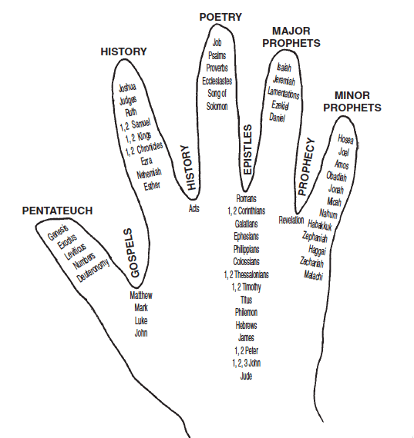Part 2 of the Series: How the Bible Is Organized
“Whatever was written in earlier times was written for our instruction…” — Romans 15:4 (LSB)
Introduction: Foundations of the Faith
The Old Testament is often misunderstood. Some think it’s outdated or irrelevant. But without the Old Testament, the New Testament loses its roots. Jesus quoted it, fulfilled it, and taught from it. The apostles built their theology on it. The early church read it as sacred Scripture.
In this second article in our series, we’ll explore how the Old Testament is structured, how it was transmitted and preserved, and why it still matters for every believer today.
The Structure of the Old Testament
The Old Testament in Protestant Bibles contains 39 books, arranged in four sections:
Memorization Device: 5-12-5-5-12
• 5 Books of the Law (Pentateuch): Genesis, Exodus, Leviticus, Numbers, Deuteronomy
• 12 Historical Books: Joshua, Judges, Ruth, 1 & 2 Samuel, 1 & 2 Kings, 1 & 2 Chronicles, Ezra, Nehemiah, Esther
• 5 Wisdom Books: Job, Psalms, Proverbs, Ecclesiastes, Song of Solomon
• 5 Major Prophets: Isaiah, Jeremiah, Lamentations, Ezekiel, Daniel
• 12 Minor Prophets: Hosea through Malachi

While not originally organized this way in the Hebrew Bible (Tanakh), this structure helps readers grasp the Bible’s covenantal and literary development.
The Tanakh: The Hebrew Bible’s Threefold Division
Jewish tradition arranges the Old Testament differently, in three divisions:
• Torah (Law): Genesis through Deuteronomy
• Nevi’im (Prophets): Joshua through Kings (Former Prophets) and Isaiah through Malachi (Latter Prophets)
• Ketuvim (Writings): Psalms, Proverbs, Job, and other poetic and historical books
Jesus refers to this threefold division in Luke 24:44: “the Law of Moses, the Prophets, and the Psalms.”
This division reflects the Jewish community’s reverence for covenant (Torah), calling (Prophets), and wisdom (Writings).
Canon Formation: Prophets, Not Committees
The canon of the Old Testament developed organically under God’s providence:
1. Initial Revelation: God Himself wrote the Ten Commandments (Ex. 31:18)
2. Mosaic Authorship: Moses wrote the Torah and stored it by the Ark (Deut. 31:24–26)
3. Prophetic Contributions: Samuel, Isaiah, Jeremiah, and others added inspired writings over time (cf. 1 Chron. 29:29; Jer. 30:2)
4. Closure Around 435 BC: After Malachi, Jewish writings speak of the cessation of prophecy (1 Macc. 9:27; Talmud Sanh. 11a)
No divine books were added after Malachi. This silence prepared the way for the Messiah.
The Role of the Dead Sea Scrolls
The Dead Sea Scrolls (DSS), discovered between 1947–1956, provided manuscripts of nearly every OT book, dating back to 250 BC.
Key insights:
• DSS confirm early recognition of Scripture (especially Deuteronomy, Isaiah, and Psalms)
• Show multiple textual streams (proto-MT, LXX base, Samaritan Pentateuch)
• Reinforce that canon recognition preceded the Masoretic Text
Textual Transmission: Trustworthy and Reverent
Scribes didn’t invent Scripture—they preserved it:
• Used animal skins, ritual cleansing, ink recipes
• Counted every letter and line (Masoretic precision)
• Marginal notes marked uncertain words but did not alter the text
Despite variants, the level of agreement among manuscripts is remarkable. The Masoretic Text, finalized around 100 AD, remains foundational to today’s Hebrew Bible.
The discovery of the DSS proved that scribal fidelity had preserved the text across a thousand years.
What About the Apocrypha?
Books like Tobit, Judith, and 1 Maccabees were included in the Greek Septuagint (LXX) but not recognized as Scripture by the Jews.
• No evidence Jesus or His apostles quoted them as Scripture
• Rejected by early Jewish authorities and most early church fathers
• Officially added to the Catholic canon at the Council of Trent (1546), not before
These books have historical value but lack divine authority.
Why the Old Testament Still Matters
• It’s the foundation of biblical theology: creation, covenant, law, kingship, sacrifice, prophecy
• It testifies to Christ: Luke 24:27 — “beginning with Moses and all the Prophets, He interpreted to them… the things concerning Himself”
• It is for our instruction: Romans 15:4; 2 Timothy 3:16–17
You cannot understand the Gospel apart from the Law, the Prophets, and the Writings.
Application: Read with the End in Mind
The Old Testament ends with longing—for a coming prophet, priest, and king. That longing finds its answer in Jesus Christ.
Reading the Old Testament is like watching the stage set for the arrival of the main character. Don’t skip Act One.
Coming Next:
• Part 3: How the New Testament Is Organized
Explore how the apostles, under the Spirit’s guidance, recorded the fulfillment of God’s redemptive plan in the person and work of Jesus.





